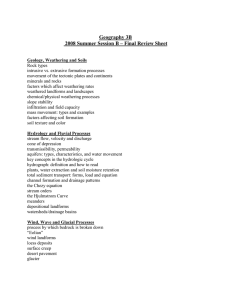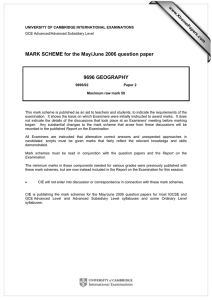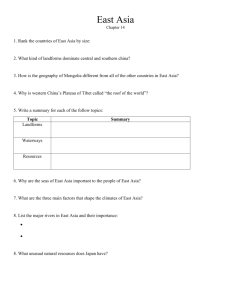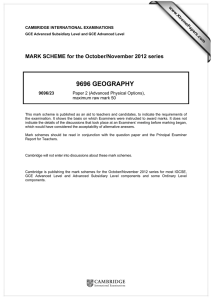9696 GEOGRAPHY MARK SCHEME for the May/June 2011 question paper
advertisement
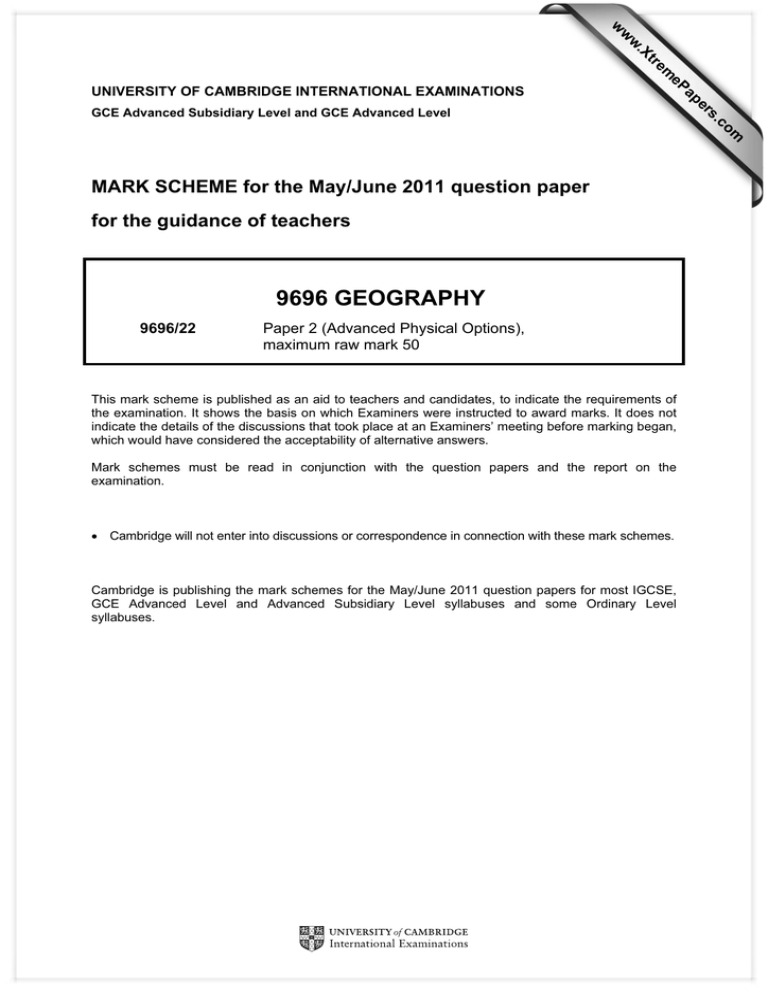
w w ap eP m e tr .X w UNIVERSITY OF CAMBRIDGE INTERNATIONAL EXAMINATIONS for the guidance of teachers 9696 GEOGRAPHY 9696/22 Paper 2 (Advanced Physical Options), maximum raw mark 50 This mark scheme is published as an aid to teachers and candidates, to indicate the requirements of the examination. It shows the basis on which Examiners were instructed to award marks. It does not indicate the details of the discussions that took place at an Examiners’ meeting before marking began, which would have considered the acceptability of alternative answers. Mark schemes must be read in conjunction with the question papers and the report on the examination. • Cambridge will not enter into discussions or correspondence in connection with these mark schemes. Cambridge is publishing the mark schemes for the May/June 2011 question papers for most IGCSE, GCE Advanced Level and Advanced Subsidiary Level syllabuses and some Ordinary Level syllabuses. om .c MARK SCHEME for the May/June 2011 question paper s er GCE Advanced Subsidiary Level and GCE Advanced Level Page 2 1. Mark Scheme: Teachers’ version GCE AS/A LEVEL – May/June 2011 Syllabus 9696 Paper 22 Fig. 1 shows a typical soil profile in a tropical environment. (a) Describe and explain how soil forming processes lead to the development of such a profile. [10] The high annual temperature and high annual rainfall leads to rapid chemical weathering of bedrock. This leads to a deep profile, up to 30 m deep. In addition, the continuous leaf fall in the ecosystem provides a substantial litter layer. However as the decomposition is rapid the humus layer is thin and is quickly incorporated into the soil. There is high fauna activity which leads to the mixing of the organic matter. The iron and aluminium give the soil the red colour through the process of hydration. There is a lack of soil horizons. This is due to the continual leaching (of silica and other minerals). The high translocation results in much material being moved through the profile by water. (b) For either the tropical rainforest or the savanna ecosystem, discuss the extent to which a sustainable approach to management can be a success. [15] A sustainable approach to management helps to ensure that the ecosystem is able to replace itself at a greater rate than it is being destroyed. However this is not always possible, as some damage is difficult to overcome. In addition there are a variety of approaches to management, depending on what the case study has drawn out. The level of sustainability can be judged also on the management of other areas connected with the ecosystem discussed; for example local crafts and economy, breeding programmes and ecotourism. Thus management may encompass a reduction in the harmful use of the ecosystem or the protection and enhancement of the social and economic conditions which enable a decrease in the dependence on non sustainable practice. The examples used may draw out the conflicts that occur with the variety of strategies to management as well as how success could be measured. Level 3 A full appreciation of the issues and success or otherwise of various schemes. Reference to examples or a detailed case study would be characteristic of this level. (12–15) Level 2 Some appreciation of the extent that managing an ecosystem can be a success. Aware of some of the limits to the management. (7–11) Level 1 A simplistic grasp of the ecosystem, with an outline of what a sustainable approach consists of. (0–6) © University of Cambridge International Examinations 2011 Page 3 2 Mark Scheme: Teachers’ version GCE AS/A LEVEL – May/June 2011 Syllabus 9696 Paper 22 (a) With the aid of a diagram, or diagrams, describe the patterns of nutrient cycling in either the tropical rain forests or savannas. For either the tropical rainforest or the savanna, explain how human exploitation may affect nutrient cycling. [10] Nutrient cycling – best achieved with reference to Gersmehl diagrams, in TRF rapid cycling with large flow from litter to soil and uptake to biomass, by far the largest store, then large fall to the litter store but small litter store due to rapid breakdown / decomposition and nutrient flow into a larger soil store. In the savanna, the three stores and flows are more equal. We do not demand explanation although some explanation may add to description. Human exploitation – TRF – removal of forest and hence loss of biomass reducing litter and nutrient addition to soil, but less take up so that soil store increases. Agriculture will add biomass but harvesting will remove nutrients from the ecosystem. Some input possible from fertilizers. ‘Slash and burn’ will increase soil store but gradual depletion as store is exhausted by cultivation. Savanna – similar factors will apply but changes will be less dramatic. Soil store will be rapidly reduced. (b) Explain the nature and effectiveness of weathering processes operating under humid and seasonably humid tropical conditions. Describe and explain the part played by weathering in the development of landforms in areas of either granite or limestone in tropical environments. [15] Both chemical and physical processes are appropriate but the link to climate must be made as well as an understanding of effectiveness. Chemical weathering most effective in humid tropics where chemical reactions are favoured by high temperatures and abundant soil moisture. Hydrolysis, carbonation and chelation (humic acids) with deep weathering and thick regolith reducing any effective physical weathering. In sub-humid tropics, scope for physical weathering: exfoliation and granular disintegration. Good candidates should recognise that chemical and physical weathering often act in conjunction. Many will stress the importance of freeze thaw fracturing which is only acceptable if restricted to extreme highland areas within the tropics! Clear diagrams can be effectively used for the areas of either granite or limestone. Detail of specific processes should be incorporated in the explanation. In both types, weathering is most concentrated along joints and bedding/pseudo bedding planes. Deep weathering to a basal surface and exhumation to expose different landforms should feature for granite (tors, bornhardts etc.). With limestone, clints, grykes, dolines, tower and cockpit karst but many will still consider caves stalagmites/stalactites the most significant and should get minimal credit for them. © University of Cambridge International Examinations 2011 Page 4 Mark Scheme: Teachers’ version GCE AS/A LEVEL – May/June 2011 Syllabus 9696 Paper 22 Level 3 Balanced answers with good knowledge of processes and their effectiveness in the different climates. Detail and coverage of specific chemical and physical weathering types will be accurate as will an understanding of the properties of granite or limestone. The role of weathering, linked to other factors, in the development of landforms will be clearly demonstrated and there will be a good knowledge of the scale and morphology of the landforms per se with clear supporting diagrams and possibly examples. (12–15) Level 2 Explanation of weathering will be in less precise terms and depth of understanding of the link to the climates limited. Similarly, accurate knowledge of granite, or limestone, and how types of weathering affect them will lack fine detail. There will be a general understanding of how landforms develop but some lack of precision in the stages and processes. (7–11) Level 1 Weak specific knowledge of appropriate weathering types and limited coverage. The role of the climate will be minimal and vague. The role of weathering vis-à-vis other factors will not be appreciated and landform coverage and detail will be weak. (0–6) 3. Fig. 2 shows some coastal landforms. (a) Describe the landforms shown in Fig.2 and explain how they were formed. [10] The diagram shows an extensive wave cut platform with receding cliffs developed in a large scale jointed material. Residual features left by the cliff recession include stacks, stumps and arches. Active erosion is reflected by a cave and wave cut notch These can be explained through the operation of marine processes on suitable geology in a high energy environment. The processes will include hydraulic action, quarrying and abrasion. Good candidates should mention the role of geology and of sub-aerial processes. (b) Using examples, explain the extent to which human activities have influenced depositional processes and landforms in coastal areas. [15] An opportunity for candidates to develop their own examples or case study so a full range of all coastal landforms are not required. It is perfectly acceptable for candidates to concentrate on only some sedimentary landforms such as spits, saltmarshes, dunes or beaches. The emphasis should be on the landforms and the balance between natural processes and human activities in the development of the coastal landforms. Many I suspect will dive straight into coastal protection and attendant hard engineering with little attention to the landforms. Better responses will develop depositional processes in terms of sediment cells and human interference with sediment sources, transportation and deposition. Level 3 Well chosen examples of coastal landforms with some assessment of the relative balance of influence of physical processes (usually dominant) and human activities. (12–15) Level 2 Concentration upon human activities be it leisure, coastal development or protection but with some recognition of landforms and of depositional processes. (7–11) Level 1 Mostly coastal protection through hard engineering schemes with little/no attention to any landforms. (0–6) © University of Cambridge International Examinations 2011 Page 5 4 Mark Scheme: Teachers’ version GCE AS/A LEVEL – May/June 2011 Syllabus 9696 Paper 22 (a) Explain how different types of wave are generated and describe their effects on beaches. [10] Waves are generated by friction between wind and water and hence are dependent on fetch, duration of wind and water depth. This produces an orbital movement of water inducing a wave. The waves can be of various types, amplitudes and wavelengths. Swell, storm, breaking waves, etc. although most will concentrate on the type at the coast – destructive or constructive. These help create the beach profile with the constructive waves pushing material up the beach and hence steepening the profile, whilst destructive waves comb material down the beach, lessening the beach profile. (b) Describe and assess the success of attempts to manage sustainably a stretch or stretches of coastline. [15] This is an opportunity for a case study or a set of examples discussing attempts at coastal management. This could encompass far more than mere coastal protection and may well involve managed retreat and the destruction of coastal protection to allow the reestablishment of salt marshes as in Essex. Inevitably many will see this as an opportunity to develop examples of protection from coastal retreat, but this should involve actual examples and include some assessment of the level of success. Probably few will approach sustainability in depth. Level 3 Well chosen case study or examples that embrace management rather than just protection schemes. There is assessment of success (or failure) and of sustainability. (12–15) Level 2 Examples or case study described with some accuracy and some attempt to see the scheme(s), rather than the management in terms of cost and benefit. (7–11) Level 1 Random examples of coastal protection methods (groynes, gabions, sea walls, etc.) with little specific location or assessment. (0–6) © University of Cambridge International Examinations 2011 Page 6 5 Mark Scheme: Teachers’ version GCE AS/A LEVEL – May/June 2011 Syllabus 9696 Paper 22 (a) Fig. 3 shows the location and magnitude of earthquakes in one week in June 2010. Use Fig. 3 to describe the world distribution of earthquakes in June 2010. Explain how an earthquake may have been generated at one of the areas shown. [10] Distribution: principally the Pacific ring of fire, a line through the Caribbean, one along the eastern Indian ocean and a few scattered others. Explanation of one occurrence: probably the San Andreas (credit accurate detail) or the more usual convergent plates with subduction, as along the west coast of South America. Allow divergent plates from any located in mid-oceans even though they may not be diverging in practice! (b) Describe the types of hazard created by volcanic eruptions. What measures can be taken to reduce the impact of such hazards and how effective are they? [15] Types of hazard: balance quantity against accuracy of description. Expect three types for full credit from pyroclastic flow (nuées ardentes), lava flows, mudflows, pyroclastic and ash fall out, gas clouds. Also allow effect on local weather and world climate. Measures to reduce impact and effectiveness: prediction with evacuation, diverting / bombing lava flows, building construction plus the list of ‘education, first aid support, infrastructure with effectiveness linked to LEDCs v MEDCs, and so on. Level 3 Well balanced answers with relevant detail backed up with examples. An understanding of the degree of hazard posed by different types of eruption and their products. Precision and detail in the measures taken to reduce the impacts with their effectiveness well addressed. (12–15) Level 2 Coverage of the demands of the question but lacking accurate detail in some areas and limited use of examples. Description of types of hazard more likely to be well answered than measures to reduce their effects. (7–11) Level 1 Weak detail/precision in describing the hazardous effects of types of eruption and coverage limited. Inappropriate, or lack of, examples. Lacking accurate detail of measures to reduce the impact of the hazards and very limited or no evaluation of their effectiveness. (0–6) © University of Cambridge International Examinations 2011 Page 7 6 Mark Scheme: Teachers’ version GCE AS/A LEVEL – May/June 2011 Syllabus 9696 Paper 22 (a) Explain the nature of tropical storms (hurricanes) and describe where they most frequently occur. [10] Hurricanes are very large systems of intense low pressure. They occur in areas of warm seas, generally 5–20 degrees N and S of the equator (sufficient to impart coriolis spin). They have high wind speeds revolving around a calmer core (eye), with massive uplift within the wall of the eye and possible descent of air within the eye. Winds reach very high speeds and are accompanied by intense precipitation. Their main impact is on the eastern side of continents. (b) To what extent is it possible to predict hurricanes and to limit the loss of life from their hazardous effects? [15] Although the season of occurrence of hurricanes is well known, as are the areas most at risk, their occurrence is all but impossible to predict. Once formed from storms over the oceans, the systems can be tracked and their arrival at the coast can be estimated and their intensity forecast. Even with the technology available to the USA (aircraft, satellites, remote sensing instrumentation) the precise forecasting of strength and landfall are still well short of perfect. It is possible to give some advance warning along fairly large stretches of coast so that evacuation can take place. In LEDCs this is generally neither possible nor feasible. The most effective measures limiting loss of life are in terms of long term land use and building planning to avoid flood plain areas, use vegetation to provide wind breaks, strengthen sea defences and stabilise slopes. This requires a level of investment beyond that of many LEDCs and even the USA did little to minimise the impact of Katrina. Level 3 Good appreciation of the limits of prediction and forecasting. Action taken in both short and long term assessed against the hazards posed by hurricanes. Exemplification from events such as Katrina. (12–15) Level 2 More on the hazardous effects than on their prediction or limitation. Emphasis on the destructive power of events, often by example. (7–11) Level 1 High winds and floods bring about disasters with little appreciation of either monitoring or any prior actions to limit loss of life. (0–6) © University of Cambridge International Examinations 2011 Page 8 7 Mark Scheme: Teachers’ version GCE AS/A LEVEL – May/June 2011 Syllabus 9696 Paper 22 Fig. 4 shows some types of sand dunes found in deserts. (a) Describe and explain the different shapes of the desert sand dunes. [10] The description should cover the four types of dune shown. The higher marks would be given to the candidates who are able to suggest details such as scales and locations or present clear and detailed drawings. Transverse dunes typically form with a unimodal wind system, linear dunes from bimodal wind system and star dunes from a multi modal wind system. Topological barriers help to encourage transverse dunes systems, whereas more flat topology produces more longitudinal forms. The explanation can cover several factors. Firstly the dominant wind direction and the influence that wind speed has. The role of vegetation may be referred to. Topography and obstacles may also be a factor discussed. Credit local names for dunes (for example linear dunes are sometimes referred to as seif dunes). Does not need to have excellent detail for all four to gain full marks. Max 9 if only three are described/explained. (b) Using an example explain why the nature of either an arid or a semi arid environment poses problems in its management. [15] One key issue here is the lack of water. Whilst supplies may be utilised from say groundwater, the extent to which the use is sustainable is limited. The environment itself may appear to be stable. However it is all too easy for humans to upset this balance and cause irreversible damage. It is therefore essential that the area is managed carefully. The fragile cryptobiotic crust and limited carrying capacity of these areas are two factors which need careful consideration when managing the area. Very quickly any damage can lead to deterioration of the environment and for instance the increase in desertification. Level 3 A well chosen case study which clearly illustrates the problems of managing this ecosystem. This is balanced with a good awareness of the environment which the candidate discusses. (12 –15) Level 2 A reasonable coverage of a case study which illustrates the problems posed by the nature of the environment. The problems caused by the nature of the environment are discussed in a more superficial manner. There is limited exemplification and detail. (7–11) Level 1 A limited knowledge of a case study (if any). Simplistic understanding of the environment, and little appreciation of the nature of its fragility. (0–6) © University of Cambridge International Examinations 2011 Page 9 8 Mark Scheme: Teachers’ version GCE AS/A LEVEL – May/June 2011 Syllabus 9696 (a) Describe how plants are adapted to drought conditions in hot deserts. Paper 22 [10] To survive, desert plants have adapted to the extremes of heat and aridity by using both physical and behavioural mechanisms. Xerophytes (adapted for aridity), such as cacti, usually have special means of storing and conserving water. They have few or no leaves, to reduce transpiration, shallow root systems, ability to store water in their stems, spines for shade and waxy skin. Phreatophytes grow extremely long roots, allowing them to acquire moisture at or near the water table. The creosote bush is one of the most successful of all desert species because it uses a combination of many adaptations. Instead of thorns, it relies for protection on a smell and taste which wildlife don’t like. It has tiny leaves that close their stomata (pores) during the day to avoid water loss and open them at night to absorb moisture. Other desert plants, using behavioural adaptations, appear during seasons of greatest moisture and/or coolest temperatures. These are usually perennials, plants that live for several years, and annuals, plants that live for only a season. Perennials often survive by remaining dormant during dry periods of the year, then springing to life when water becomes available. Most annual desert plants germinate only after heavy seasonal rain, and complete their cycle in a matter of weeks. Deserts are actually diverse environments and comprise of a multitude of micro-climates changing from year to year. Desert plants must respond quickly when heat, moisture and light levels are suitable. (b) What are the main sources of water in hot deserts? sustainable development in these areas? How might these influence [15] The seasons are generally warm throughout the year and very hot in the summer. The winters usually bring little rainfall. Rainfall is very low and/or concentrated in short bursts between long rainless periods and falls in the form of sudden, violent thunderstorms. Evaporation rates regularly exceed rainfall rates. There may be several storms in a year, or none for several years: average rainfall is, therefore, deceptive. Deserts receive runoff from ephemeral, or short-lived, streams fed by rain and snow from adjacent highlands. A few deserts are crossed by 'exotic' rivers (such as the Nile, the Colorado, and the Yellow Rivers) that derive their water from outside the desert. Such rivers infiltrate soils and evaporate large amounts of water on their journeys through the deserts. Aquifers underlie many deserts with water passing through permeable strata from areas outside of the arid zone or they may contain water from when the current arid areas were much wetter. The limited amount of water from rainfall received by a desert is eventually either lost by evaporation, or percolates through loose sediments and permeable layers below the surface of the earth giving rise to groundwater. Deserts may also have underground springs, rivers, or reservoirs that lie close to the surface, or deep underground (oases). Dew and fog may play an important role, especially where dew fall exceeds rainfall during periods of drought – e.g. Namib Desert. Sustainability needs to be addressed in terms of water usage to sustain agriculture and life such that the use of water does not exceed the supply, though this may well be happening © University of Cambridge International Examinations 2011 Page 10 Mark Scheme: Teachers’ version GCE AS/A LEVEL – May/June 2011 Syllabus 9696 Paper 22 with ancient aquifers. Damns up stream of deserts may reduce flow of water (Colorado) and so make agriculture unsustainable. On the other hand the Aswan dam provides water to irrigate the desert. Some discussion of salinisation would be expected of good candidates Level 3 A good appreciation that desert water supply is not just reliant on infrequent rainfall, but that ephemeral streams, exotic rivers, aquifers and dew are important. Relates water availability to sustainable use without damaging supply or environmental degradation (salinisation etc.). (12–15) Level 2 Will be an awareness that rain rarely falls in deserts and if it does, it usually falls in the form of sudden, violent thunderstorms. Some appreciation of other sources. Limited relationship between water supply and sustainability. (7–11) Level 1 A simple account focusing on lack of water supply in hot deserts. Emphasis will be on lack of rainfall and a simple definition of deserts. Little, if any, idea of sustainability. (0–6) © University of Cambridge International Examinations 2011


